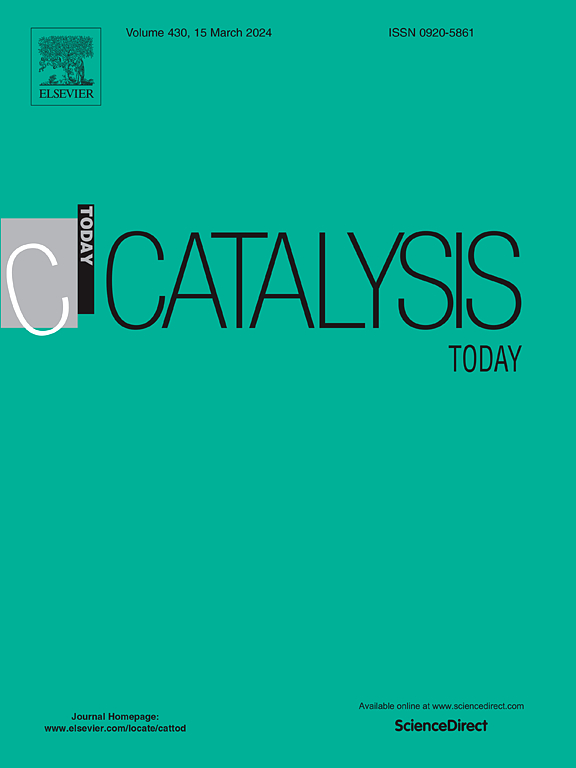Methane tri-reforming over Ni, Ru monometallic and Ni-Ru bimetallic catalyst supported on MIL-53 metal-organic framework
IF 5.2
2区 化学
Q1 CHEMISTRY, APPLIED
引用次数: 0
Abstract
Methane tri-reforming (MTR) is a promising approach for the utilization of anthropogenic greenhouse gases such as CH4 and CO2 to produce syngas. In this work, the activities of monometallic (Ru, Ni) and bimetallic (Ru-Ni) catalysts supported on the alumina derived from metal-organic framework (MOF) precursors were compared for MTR. The catalysts were synthesized by impregnation technique, and their activity was investigated in a packed bed-down flow tubular reactor over a temperature range of 600–800 °C at 1 atm. The catalyst structure-activity relationship was determined with the help of extensive catalyst characterization techniques, including N2 physisorption, X-ray diffraction (XRD), temperature-programmed reduction (TPR), and CO2 temperature-programmed desorption (CO2-TPD). Experimental results demonstrated that the bimetallic catalyst was more active as compared to monometallic one. Among the bimetallic catalysts, 0.65RuNAlM-53 catalyst demonstrated comparatively high CO2 conversion (36.1 %) and an almost complete conversion of CH4 (99.9 %) with an H2/CO ratio of 3.2 at 800 °C. The 0.65RuNAlM-53 catalyst showed consistent activity for a prolonged duration of > 125 h with no carbon deposition. Based on the experimental observation, a probable reaction mechanism is proposed for the MTR. The catalyst structure was intact even after 125 h of reaction, which suggested the MOF-derived Ru-Ni bimetallic catalyst developed is very promising for MTR.
MIL-53金属有机骨架上Ni、Ru单金属和Ni-Ru双金属催化剂上的甲烷三重整
甲烷三重整(MTR)是利用CH4和CO2等人为温室气体生产合成气的一种很有前途的方法。本文比较了金属有机骨架(MOF)前驱体氧化铝负载的单金属(Ru, Ni)和双金属(Ru-Ni)催化剂的MTR活性。采用浸渍法制备了催化剂,并在1 atm温度600 ~ 800 °C的填充床下流动管式反应器中考察了催化剂的活性。通过广泛的催化剂表征技术,包括N2物理吸附、x射线衍射(XRD)、程序升温还原(TPR)和程序升温解吸(CO2- tpd),确定了催化剂的构效关系。实验结果表明,与单金属催化剂相比,双金属催化剂具有更高的活性。在双金属催化剂中,0.65RuNAlM-53催化剂表现出较高的CO2转化率(36.1% %)和几乎完全的CH4转化率(99.9 %),在800 °C时H2/CO比为3.2。0.65RuNAlM-53催化剂在>; 125 h的长时间内表现出一致的活性,没有碳沉积。根据实验观察,提出了一种可能的MTR反应机理。反应时间达到125 h后,催化剂结构仍保持完整,表明mof衍生的Ru-Ni双金属催化剂具有良好的应用前景。
本文章由计算机程序翻译,如有差异,请以英文原文为准。
求助全文
约1分钟内获得全文
求助全文
来源期刊

Catalysis Today
化学-工程:化工
CiteScore
11.50
自引率
3.80%
发文量
573
审稿时长
2.9 months
期刊介绍:
Catalysis Today focuses on the rapid publication of original invited papers devoted to currently important topics in catalysis and related subjects. The journal only publishes special issues (Proposing a Catalysis Today Special Issue), each of which is supervised by Guest Editors who recruit individual papers and oversee the peer review process. Catalysis Today offers researchers in the field of catalysis in-depth overviews of topical issues.
Both fundamental and applied aspects of catalysis are covered. Subjects such as catalysis of immobilized organometallic and biocatalytic systems are welcome. Subjects related to catalysis such as experimental techniques, adsorption, process technology, synthesis, in situ characterization, computational, theoretical modeling, imaging and others are included if there is a clear relationship to catalysis.
 求助内容:
求助内容: 应助结果提醒方式:
应助结果提醒方式:


